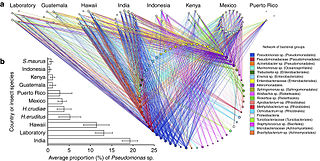
Botrytis cinerea is a necrotrophic fungus that affects many plant species, although its most notable hosts may be wine grapes. In viticulture, it is commonly known as "botrytis bunch rot"; in horticulture, it is usually called "grey mould" or "gray mold".

Pseudomonas is a genus of Gram-negative, Gammaproteobacteria, belonging to the family Pseudomonadaceae and containing 191 validly described species. The members of the genus demonstrate a great deal of metabolic diversity and consequently are able to colonize a wide range of niches. Their ease of culture in vitro and availability of an increasing number of Pseudomonas strain genome sequences has made the genus an excellent focus for scientific research; the best studied species include P. aeruginosa in its role as an opportunistic human pathogen, the plant pathogen P. syringae, the soil bacterium P. putida, and the plant growth-promoting P. fluorescens, P. lini, P. migulae, and P. graminis.

Halomonadaceae is a family of halophilic Proteobacteria.
Rubrobacter is a genus of Actinobacteria. It is radiotolerant and may rival Deinococcus radiodurans in this regard.
"Pseudomonas blatchfordae" is a Gram-negative soil bacteria isolated from tomato pith necrosis and the common bean. It is not a validly recognized species. Based on 16S rRNA analysis, it falls within the P. fluorescens group.

Pseudomonas savastanoi is a gram-negative plant pathogenic bacterium that infects a variety of plants. It was once considered a pathovar of Pseudomonas syringae, but following DNA-relatedness studies, it was instated as a new species. It is named after Savastano, a worker who proved between 1887 and 1898 that olive knot are caused by bacteria.
Pseudomonas brassicacearum is a Gram-negative soil bacterium that infects the roots of Brassica napus, from which it derives its name. Based on 16S rRNA analysis, P. brassicacearum falls within the P. fluorescens group. It has also been shown to have both pathogenic and plant growth-promoting effects on tomato plants.

Pseudomonas fulva is a Gram-negative environmental bacterium, originally isolated from rice and commonly associated with rice plants, grains and paddy fields. It is rod-shaped and motile using one to three polar flagella.
Pseudomonas moraviensis is a Gram-negative soil bacterium. It is named after Moravia, the region of the Czech Republic where it was first isolated. The type strain is CCM 7280T.
Pseudomonas vranovensis is a Gram-negative soil bacterium.
Pseudomonas cedrina is a Gram-negative, rod-shaped bacterium isolated from spring waters in Lebanon. Based on 16S rRNA analysis, P. cedrina has been placed in the P. fluorescens group.
Pseudomonas orientalis is a Gram-negative, rod-shaped bacterium isolated from spring waters in Lebanon. Based on 16S rRNA analysis, P. orientalis has been placed in the P. fluorescens group.
Pseudomonas mandelii is a fluorescent, Gram-negative, rod-shaped bacterium isolated from natural spring waters in France. Based on 16S rRNA analysis, P. mandelii has been placed in the P. fluorescens group.
Pseudomonas jessenii is a fluorescent, Gram-negative, rod-shaped bacterium isolated from natural mineral waters in France. The type strain is CIP 105274.
Pseudomonas cremoricolorata is a Gram-negative bacteria found living on plants.
Clonostachys rosea f. rosea, also known as Gliocladium roseum, is a species of fungus in the family Bionectriaceae. It colonizes living plants as an endophyte, digests material in soil as a saprophyte and is also known as a parasite of other fungi and of nematodes. It produces a wide range of volatile organic compounds which are toxic to organisms including other fungi, bacteria, and insects, and is of interest as a biological pest control agent.
Pseudomonas infection refers to a disease caused by one of the species of the genus Pseudomonas.

Deinococcus is in the monotypic family Deinococcaceae, and one genus of three in the order Deinococcales of the bacterial phylum Deinococcota highly resistant to environmental hazards. These bacteria have thick cell walls that give them Gram-positive stains, but they include a second membrane and so are closer in structure to Gram-negative bacteria. Deinococcus survive when their DNA is exposed to high doses of gamma and UV radiation. Whereas other bacteria change their structure in the presence of radiation, such as by forming endospores, Deinococcus tolerate it without changing their cellular form and do not retreat into a hardened structure. They are also characterized by the presence of the carotenoid pigment deinoxanthin that give them their pink color. They are usually isolated according to these two criteria. In August 2020, scientists reported that bacteria from Earth, particularly Deinococcus bacteria, were found to survive for three years in outer space, based on studies conducted on the International Space Station. These findings support the notion of panspermia, the hypothesis that life exists throughout the Universe, distributed in various ways, including space dust, meteoroids, asteroids, comets, planetoids or contaminated spacecraft.
Agromyces is a genus in the phylum Actinomycetota (Bacteria).
Weissella thailandensis is a species of Gram-positive bacteria. It is a homofermentative, sphere-shaped lactic acid bacteria. Its type strain is FS61-1T. Its genome has been sequenced.





